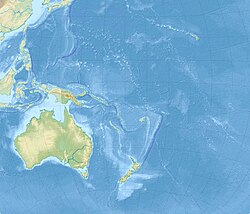Tupuangi Formation
| Tupuangi Formation | |
|---|---|
| Stratigraphic range: Cenomanian-Turonian ~ | |
 Tupuangi Formation at Waihere bay, Pitt Island | |
| Type | Geological formation |
| Unit of | Waihere Bay Group |
| Sub-units | Kokowai Allomember, Waihere Allomember, Morgan's Hollow Allomember |
| Underlies | Kahuitara Tuff |
| Overlies | Unseen |
| Thickness | Not bounded, 430 m (1,410 ft) exposed onshore, possibly 700 m (2,300 ft) offshore |
| Lithology | |
| Primary | Sandstone, siltstone |
| Other | Conglomerate |
| Location | |
| Region | Oceania |
| Country | |
| Extent | Pitt Island, Chatham Islands |
| Type section | |
| Named for | Tupuangi, Pitt Island |
| Location | Northern end of Waihere Bay |
| Coordinates | 44°15′32.8″S 176°14′57.1″W / 44.259111°S 176.249194°W |
| Approximate paleocoordinates | 78°54′S 135°54′W / 78.9°S 135.9°W |
| Thickness at type section | ~400 m (1,300 ft) |
The Tupuangi Formation is a geological formation in New Zealand, only exposed on Pitt Island in the Chatham Islands. It is the oldest exposed sedimentary unit within the archipelago. It was deposited in terrestrial deltaic to paralic conditions during the Cenomanian to Turonian ages of the Late Cretaceous. During this time period the Chatham Islands were attached to Antarctica within the Antarctic Circle, at approximately 70° to 80° south.
Description
[edit]The lithology consists of a basal conglomerate, which grades into sandstone and carbonaceous siltstone in the upper part of the formation.[1] The formation is notable for its fossil content, including many varieties of plant, including abundant conifers, including members of Araucariaceae, Podocarpaceae, Cupressaceae, Cheirolepidiaceae, as well as Ginkgo and Ginkgoites.[2][3][4] Other flora includes mosses, ferns, liverworts and lycopodians.[5] Compression fossils of insects have been found including members of Carabidae and Buprestidae,[6] and acritarch Introvertocystis.[7] Amber is also known from the deposit[8] associated with the conifer Protodammara reimatamoriori, a member of Cupressaceae.[9]
See also
[edit]References
[edit]- ^ Mays, Chris; Stilwell, Jeffrey D. (May 2013). "Pollen and spore biostratigraphy of the mid-Cretaceous Tupuangi Formation, Chatham Islands, New Zealand". Review of Palaeobotany and Palynology. 192: 79–102. Bibcode:2013RPaPa.192...79M. doi:10.1016/j.revpalbo.2012.12.008. ISSN 0034-6667.
- ^ Pole, Mike; Philippe, Marc (September 2010). "Cretaceous plant fossils of Pitt Island, the Chatham group, New Zealand". Alcheringa: An Australasian Journal of Palaeontology. 34 (3): 231–263. Bibcode:2010Alch...34..231P. doi:10.1080/03115511003659085. ISSN 0311-5518. S2CID 129301288.
- ^ Mays, Chris; Cantrill, David J. (2018-01-04). "Protodammara reimatamoriori, a new species of conifer (Cupressaceae) from the Upper Cretaceous Tupuangi Formation, Chatham Islands, Zealandia". Alcheringa: An Australasian Journal of Palaeontology. 43: 114–126. doi:10.1080/03115518.2017.1417478. ISSN 0311-5518. S2CID 133838326.
- ^ Mays, Chris; Steinthorsdottir, Margret; Stilwell, Jeffrey D. (November 2015). "Climatic implications of Ginkgoites waarrensis Douglas emend. from the south polar Tupuangi flora, Late Cretaceous (Cenomanian), Chatham Islands". Palaeogeography, Palaeoclimatology, Palaeoecology. 438: 308–326. Bibcode:2015PPP...438..308M. doi:10.1016/j.palaeo.2015.08.011.
- ^ Mays, Chris; Tosolini, Anne-Marie P.; Cantrill, David J.; Stilwell, Jeffrey D. (April 2015). "Late Cretaceous (Cenomanian–Turonian) macroflora from the Chatham Islands, New Zealand: Bryophytes, lycophytes and pteridophytes". Gondwana Research. 27 (3): 1042–1060. Bibcode:2015GondR..27.1042M. doi:10.1016/j.gr.2014.03.017. ISSN 1342-937X.
- ^ Stilwell, Jeffrey D.; Vitacca, Jesse J.; Mays, Chris (2016-04-21). "South polar greenhouse insects (Arthropoda: Insecta: Coleoptera) from the mid-Cretaceous Tupuangi Formation, Chatham Islands, eastern Zealandia". Alcheringa: An Australasian Journal of Palaeontology. 40 (4): 502–508. Bibcode:2016Alch...40..502S. doi:10.1080/03115518.2016.1144385. ISSN 0311-5518. S2CID 130271909.
- ^ Mays, Chris M.; Stilwell, Jeffrey D. (December 2012). "Judging an acritarch by its cover: the taxonomic implications of Introvertocystis rangiaotea gen. et sp. nov. from the Late Cretaceous (Cenomanian–Turonian) of the Chatham Islands, New Zealand". Palynology. 36 (2): 180–190. Bibcode:2012Paly...36..180M. doi:10.1080/01916122.2011.633633. ISSN 0191-6122. S2CID 130281612.
- ^ Stilwell, Jeffrey D.; Langendam, Andrew; Mays, Chris; Sutherland, Lachlan J. M.; Arillo, Antonio; Bickel, Daniel J.; De Silva, William T.; Pentland, Adele H.; Roghi, Guido; Price, Gregory D.; Cantrill, David J.; Quinney, Annie; Penalver, Enrique (2020-04-02). "Amber from the Triassic to Paleogene of Australia and New Zealand as exceptional preservation of poorly known terrestrial ecosystems". Scientific Reports. 10 (1): 5703. Bibcode:2020NatSR..10.5703S. doi:10.1038/s41598-020-62252-z. ISSN 2045-2322. PMC 7118147. PMID 32242031.
- ^ Mays, Chris; Coward, Andrew J.; O'Dell, Luke A.; Tappert, Ralf (January 2019). "The botanical provenance and taphonomy of Late Cretaceous Chatham amber, Chatham Islands, New Zealand". Review of Palaeobotany and Palynology. 260: 16–26. Bibcode:2019RPaPa.260...16M. doi:10.1016/j.revpalbo.2018.08.004. ISSN 0034-6667. S2CID 134533319.
- Pages using the JsonConfig extension
- Geologic formations of New Zealand
- Cretaceous System of Oceania
- Cenomanian Stage
- Turonian Stage
- Sandstone formations
- Siltstone formations
- Deltaic deposits
- Fluvial deposits
- Fossiliferous stratigraphic units of Oceania
- Paleontology in New Zealand
- Geography of the Chatham Islands

